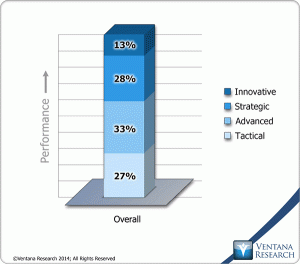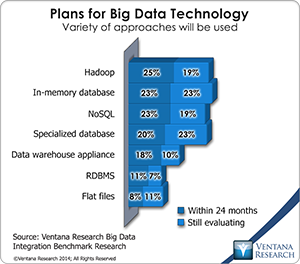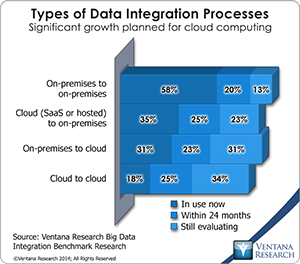Big data has great promise for many organizations today, but they also need technology to facilitate integration of various data stores, as I recently pointed out. Our big data integration benchmark research makes it clear that organizations are aware of the need to integrate big data, but most have  yet to address it: In this area our Performance Index analysis, which assesses competency and maturity of organizations, concludes that only 13 percent reach the highest of four levels, Innovative. Furthermore, while many organizations are sophisticated in dealing with the information, they are less able to handle the people-related areas, lacking the right level of training in the skills required to integrate big data. Most said that the training they provide is only somewhat adequate or inadequate.
yet to address it: In this area our Performance Index analysis, which assesses competency and maturity of organizations, concludes that only 13 percent reach the highest of four levels, Innovative. Furthermore, while many organizations are sophisticated in dealing with the information, they are less able to handle the people-related areas, lacking the right level of training in the skills required to integrate big data. Most said that the training they provide is only somewhat adequate or inadequate.
Big data is still new to many organizations, and they face challenges in integrating big data that prevent them from gaining full value from their existing and potential investments. Our research finds that many lack confidence in processing large volumes of data. More than half (55%) of organizations characterized themselves as only somewhat confident or not confident in their ability to accomplish that task. They have even less confidence in their ability to process data that arrives at high velocity: Only 29 percent said they are somewhat confident or not confident in that. In dealing with the variety of big data, confidence is somewhat stronger, as more than half (56%) declared themselves confident or very confident. Assurance in one aspect is often found in others: 86 percent of organizations that said they are very confident in their ability to integrate the variety of big data are satisfied with how they manage the storage of big data. Similarly 91 percent of those that are confident or very confident with their data quality are satisfied with the way they manage the storage of big data.
Turning to the technology being used, we find only one-third (32%) of organizations satisfied with their current data integration technology, but twice as many (66%) are satisfied with their data integration processes for loading and creating big data. A substantial majority (86%) of those very confident in their ability to integrate the needed variety of big data are  satisfied with their existing data integration processes. Those that are not satisfied said the process is too slow (61%), analytics are hard to build and maintain (50%) and data is not readily available (39%). These findings indicate that making a commitment to data integration, for big data and otherwise, can pay off in confidence and satisfaction with the processes for doing it. Additionally, organizations that use dedicated data integration technology (86%) are satisfied much more often than those that don’t use dedicated technology (52%).
satisfied with their existing data integration processes. Those that are not satisfied said the process is too slow (61%), analytics are hard to build and maintain (50%) and data is not readily available (39%). These findings indicate that making a commitment to data integration, for big data and otherwise, can pay off in confidence and satisfaction with the processes for doing it. Additionally, organizations that use dedicated data integration technology (86%) are satisfied much more often than those that don’t use dedicated technology (52%).
New types of big data technologies are being introduced to meet expanding demand for storage and use of information across the enterprise. One of those fast-growing technologies is the open source Apache Hadoop and commercial enterprise versions of it that provide a distributed file system to manage large volumes of data. The research finds that currently 28 percent of organizations use Hadoop and about as many more (25%) plan to use it in the next two years. Nearly half (47%) have Hadoop-specific skills to support big data integration. For those that have limited resources, open source Hadoop can be affordable, and to automate and interface with it, adopters can use SQL in addition to its native interfaces; about three in five organizations now use each of these options. Hadoop can be a capable tool to implement big data but must be integrated with other information and operational systems.
Big data is not found only in conventional in-house information environments. Our research finds that data integration processes are most often applied between systems deployed  on-premises (58%), but more than one-third (35%) are integrating cloud-based systems, which reflects the progress cloud computing has made. Nonetheless, cloud-to-cloud integration remains least common (18%). In the next year or two 20 to 25 percent of organizations plan additional support for all types of integration; those being considered most often are cloud-to-cloud (25%) and on-premises-to-cloud (23%), further reflecting movement into the cloud. In addition, nearly all (95%) organizations using cloud-to-cloud integration said they have improved their activities and processes. This finding confirms the value of integration of big data regardless of what types of systems hold it. With a growing number of organizations using cloud computing, data integration is a critical requirement for big data projects; more than one-quarter (28%) of organizations are deploying big data integration into cloud computing environments.
on-premises (58%), but more than one-third (35%) are integrating cloud-based systems, which reflects the progress cloud computing has made. Nonetheless, cloud-to-cloud integration remains least common (18%). In the next year or two 20 to 25 percent of organizations plan additional support for all types of integration; those being considered most often are cloud-to-cloud (25%) and on-premises-to-cloud (23%), further reflecting movement into the cloud. In addition, nearly all (95%) organizations using cloud-to-cloud integration said they have improved their activities and processes. This finding confirms the value of integration of big data regardless of what types of systems hold it. With a growing number of organizations using cloud computing, data integration is a critical requirement for big data projects; more than one-quarter (28%) of organizations are deploying big data integration into cloud computing environments.
Because of the intense need of business units and process for big data, integration requires IT and business people to work together to build efficient processes. The largest percentage of organizations in the research (44%) have business analysts work with IT to design and deploy big data integration. Another one-third assign IT to build the integration, and half that many (16%) have IT use a dedicated data integration tool. The research finds some distrust in involving the business side. Almost one in four (23%) said they are resistant or very resistant to allowing business users to integrate big data that IT has not prepared first, and the majority (51%) resist somewhat. For more than half (58%) the IT group responsible for BI and data warehouse systems also is the key stakeholder for designing and deploying big data integration; no other option is used by more than 11 percent.
It is not surprising that IT is the department that most often facilitates big data and needs integration the most (55%). The most frequent issue arising between business units and IT is entrenchment of budgets and priorities (in 42% of organizations). Funding of big data initiatives most often comes from the general IT budget (50%); line-of-business IT budgets (38%) are the second-most commonly used. It is understandable that IT dominates this heavily technical function, but big data is beneficial only when it advances the organization’s goals for information that is needed by business. Management should ensure that IT works with the lines of business to enable them to get the information they need to improve business processes and decision-making and not settle for creating a more cost-effective and efficient method to store it.
Overcoming these challenges is a critical step in the planning process for big data. My analysis that big data won’t work well without integration is confirmed by the research. We urge organizations to take a comprehensive approach to big data and evaluate dedicated tools that can mitigate risks that others have already encountered.
Regards,
Mark Smith
CEO and Chief Research Officer


 yet to address it: In this area our Performance Index analysis, which assesses competency and maturity of organizations, concludes that only 13 percent reach the highest of four levels, Innovative. Furthermore, while many organizations are sophisticated in dealing with the information, they are less able to handle the people-related areas, lacking the right level of training in the skills required to integrate big data. Most said that the training they provide is only somewhat adequate or inadequate.
yet to address it: In this area our Performance Index analysis, which assesses competency and maturity of organizations, concludes that only 13 percent reach the highest of four levels, Innovative. Furthermore, while many organizations are sophisticated in dealing with the information, they are less able to handle the people-related areas, lacking the right level of training in the skills required to integrate big data. Most said that the training they provide is only somewhat adequate or inadequate.










